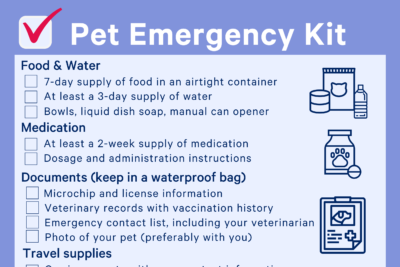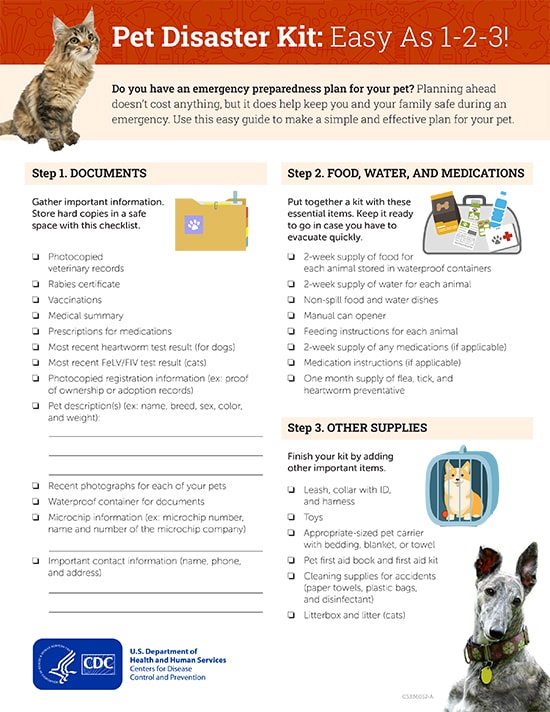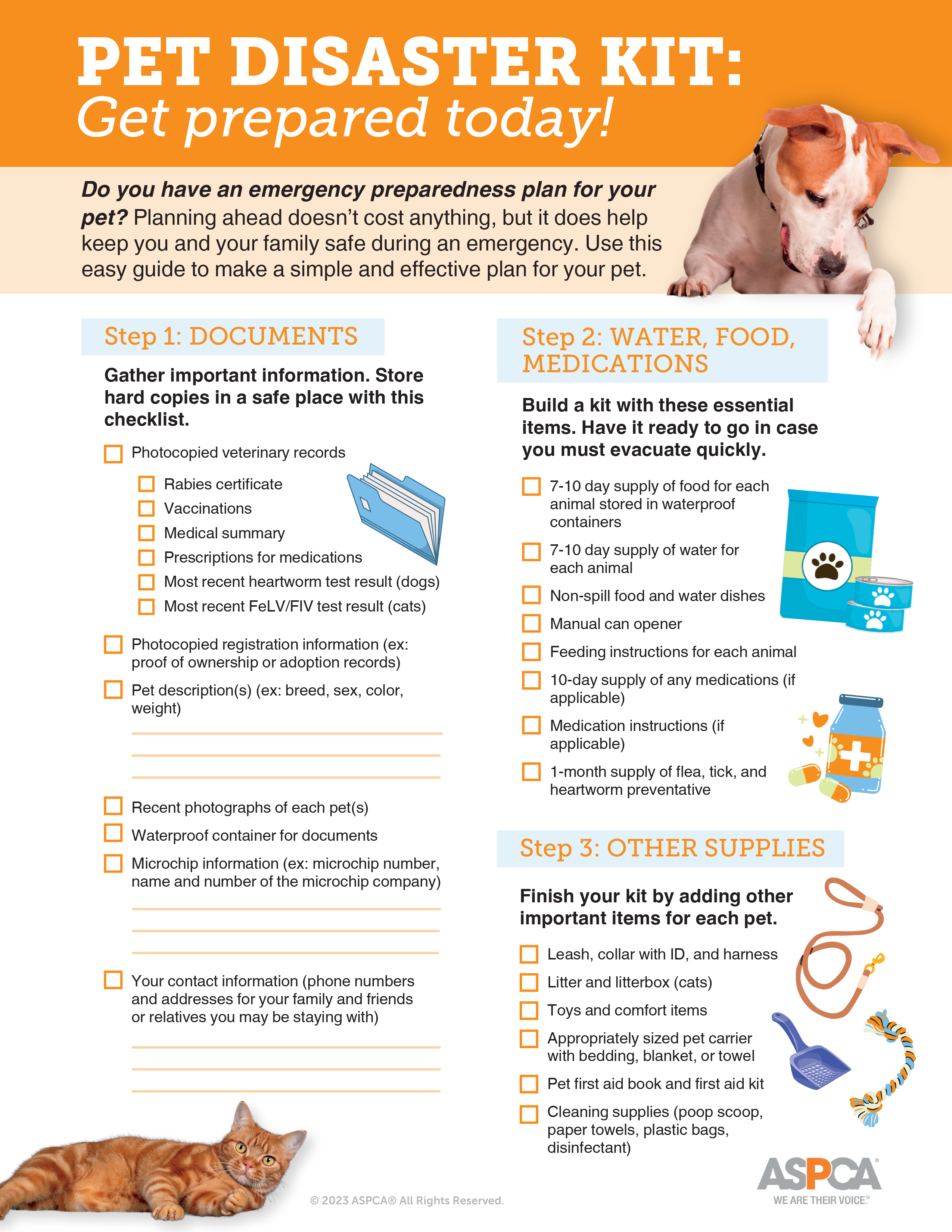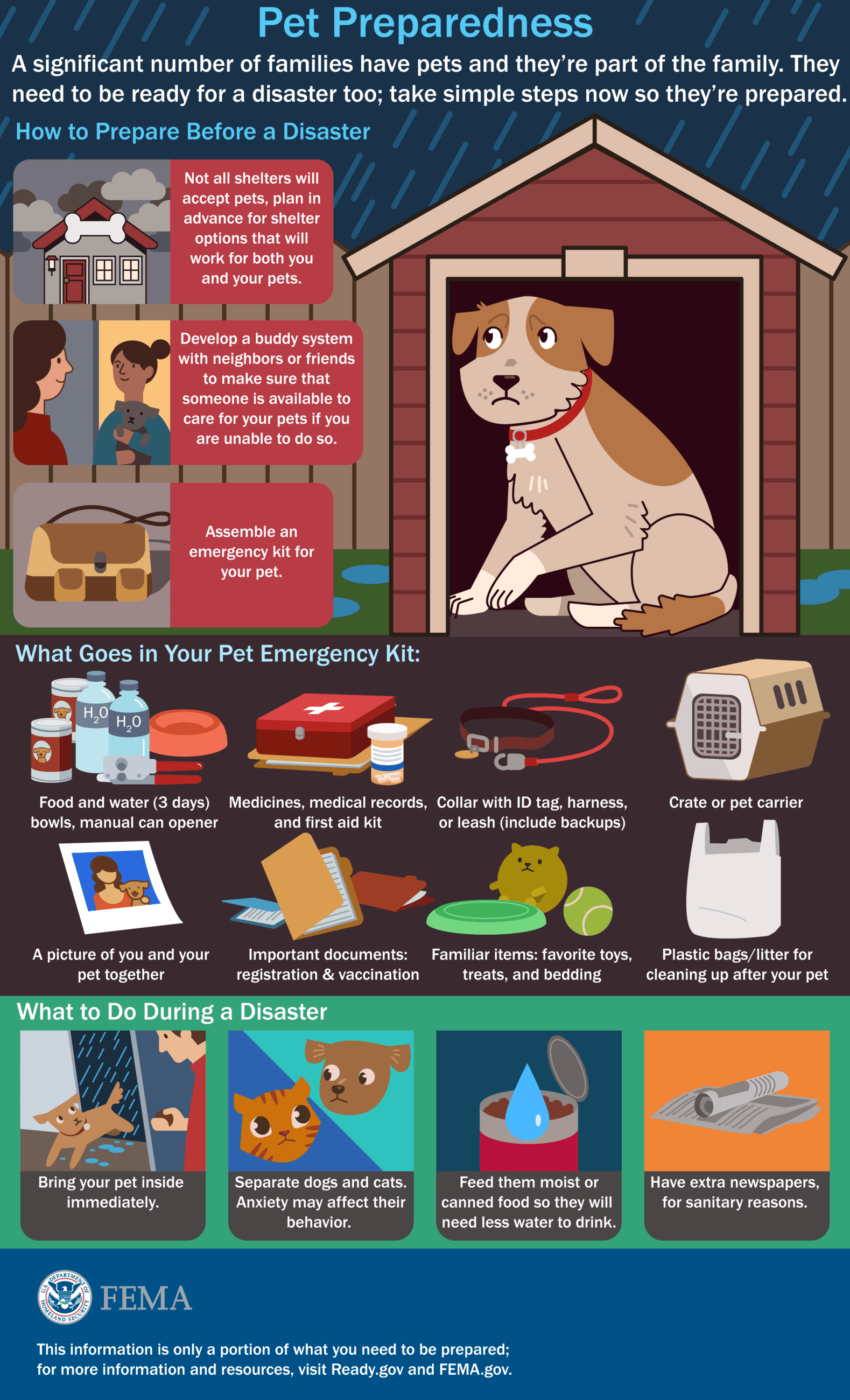Make a pet disaster plan to keep your furry friend safe during emergencies. In times of crisis, having a plan in place will ensure your pet’s well-being.
Whether it’s a natural disaster or other emergency situation, being prepared is essential. This article will guide you through the steps to create a comprehensive pet disaster plan, including assembling an emergency kit, identifying evacuation routes, and finding pet-friendly shelters.
Don’t wait until it’s too late – start planning now to protect your beloved pet during times of uncertainty.
Why You Need A Pet Disaster Plan
Ensure your pet’s safety during emergencies with a well-prepared disaster plan. Protect your furry companion by having a plan in place that includes essential supplies, designated meeting spots, and emergency contacts.
Protecting Your Pets
When disaster strikes, your pets are completely reliant on you for their safety and well-being. It is your responsibility to ensure that they are protected in emergency situations.
A pet disaster plan is a crucial part of any emergency preparedness strategy. Whether it’s a natural disaster like a hurricane or flood, or a man-made disaster such as a fire or chemical spill, having a plan in place will give you peace of mind and increase the chances of keeping your pets safe.
Here are some steps you can take to protect your pets:
- Ensure your pets are wearing collars with identification tags containing your current contact information.
- Microchip your pets to increase the chances of being reunited if they become lost or separated during a disaster.
- Keep a current photo of each of your pets along with their medical records in a waterproof, portable container.
- Create an emergency kit for your pets that includes:
| Food: | Include a supply of your pet’s regular food that will last for at least a week. |
| Water: | Have enough water for your pets to last at least five days. |
| Medications: | Include any necessary medications along with instructions for dosage. |
| Blankets and towels: | These can provide comfort and warmth for your pets during an emergency. |
| Leashes and collars: | Have extra leashes and collars in case they get damaged or lost. |
| Litter and litter box: | If you have cats, include a supply of litter and a portable litter box. |
| Comfort items: | Pack toys, bedding, or anything that can help reduce stress for your pets. |
Preparing For Emergency Situations
When preparing for emergency situations, it’s essential to consider the specific needs of your pets and adapt your plan accordingly.
Here are some key steps to help you prepare:
- Research: Identify potential hazards and risks in your area that may affect your pets. This can include natural disasters and other emergencies.
- Designate a safe area: Identify a safe area in your home where your pets can stay during an emergency. Make sure it is easily accessible and pet-proofed.
- Emergency contacts: Keep a list of emergency contacts specifically for your pets, including veterinarians, animal hospitals, and local animal shelters.
- Evacuation plan: Map out evacuation routes and know in advance where you can go with your pets. Research pet-friendly hotels, shelters, or friends and family who may be able to accommodate you and your pets.
- Practice: Regularly rehearse your pet disaster plan with your family to ensure everyone knows their roles and responsibilities.
- Stay informed: Monitor local news and weather updates to stay informed about potential emergencies. Sign up for emergency alerts that include pet-specific information.
Remember, having a pet disaster plan in place can make all the difference in keeping your pets safe and secure during emergency situations. Take the time to prepare now so that you can act swiftly and confidently when disaster strikes.

Credit: www.amcny.org
Creating Your Pet Disaster Kit
Preparing your pet for a potential disaster is crucial to ensure their safety and well-being. One of the most important steps you can take is to create a pet disaster kit. By having all the essential supplies and documents ready in advance, you can act swiftly and efficiently if the need arises. Here’s a breakdown of what you should include in your pet disaster kit:
Food And Water Supplies
When disaster strikes, ensuring that your pet has access to food and water is of utmost importance. Be sure to include enough supplies to sustain your pet for a minimum of three days. Here’s what you should consider including:
- Food: Pack a sufficient amount of your pet’s regular food in an airtight container to keep it fresh. Consider using dry food, as it has a longer shelf life.
- Water: Store enough water for both drinking and sanitation purposes. Stash away one gallon of water per day for each pet.
- Bowls: Don’t forget to pack collapsible bowls for food and water. These are lightweight and easy to carry.
Medical And Identification Records
In case of an emergency or unexpected evacuation, having your pet’s medical and identification records readily available can be a lifesaver. Here’s what you should include in this section of your pet disaster kit:
- Medical Records: Keep a copy of your pet’s vaccination records, as well as any prescriptions or veterinary information. This will come in handy if you need to visit a new veterinarian in an emergency situation.
- Identification: Ensure your pet has a collar with identification tags containing your contact information. Additionally, consider getting them microchipped, as this provides a more permanent form of identification.
By taking the time to create a comprehensive pet disaster kit, you can rest assured knowing that you are well-prepared to handle any situation that may arise. Remember to regularly check and replenish your supplies as needed, and keep your kit in an easily accessible location. By doing so, you are ensuring the safety and well-being of your furry friend, even during the most challenging times.
Safety Measures For Your Pets
In times of disaster, having a pet disaster plan in place is crucial for the safety and well-being of your furry friends. By preparing ahead, you can ensure their safety and provide them with the care they need during emergencies.
Securing Your Home
When it comes to keeping your pets safe during a disaster, securing your home should be your top priority. By taking a few precautionary measures, you can minimize the risks and ensure the well-being of your furry friends.
Here are some safety measures you can implement:
- Store hazardous materials out of reach: Keep cleaning supplies, pesticides, and other potentially harmful substances securely stored in cabinets or locked containers. This prevents your pets from accidentally ingesting or getting exposed to toxic substances.
- Create a safe space: Designate a room or area in your home where your pets can take shelter during an emergency. Make sure this space is easily accessible and has enough room for your pets to move around comfortably.
- Secure loose objects: Assess your surroundings and identify any loose objects that could pose a threat to your pets. Anchor bookshelves, secure heavy furniture, and fasten loose wires to prevent accidents or injuries.
- Install pet-friendly security devices: Consider installing pet-friendly smoke detectors and monitored security systems that can detect and alert you to potential dangers. These devices can provide an extra layer of protection for your pets when you’re not at home.
Evacuating With Your Pets
When it comes time to evacuate, it’s crucial to have a plan in place for your pets. Leaving them behind can put their lives at risk, so make sure you include them in your evacuation strategy.
Here are some tips to help you evacuate with your pets:
- Prepare a pet emergency kit: As part of your disaster preparedness, assemble a pet emergency kit that includes essential supplies such as food, water, medications, veterinary records, and comfort items like a favorite toy or blanket. Keep this kit easily accessible and ready to grab in case of an evacuation.
- Have identification for your pets: Ensure your pets have proper identification when you evacuate. Make sure their collars have up-to-date tags with your contact information. Consider microchipping your pets as an added layer of identification.
- Know pet-friendly evacuation routes and shelters: Research pet-friendly evacuation routes and shelters in your area ahead of time. Not all shelters accept pets, so it’s essential to identify those that do and familiarize yourself with their policies and requirements.
- Contact local animal shelters and hotels: In case you can’t find a pet-friendly evacuation shelter, reach out to local animal shelters and hotels to inquire about their emergency plans for pets. Some may offer temporary accommodations or referrals during a disaster situation.
By securing your home and having a plan for evacuating with your pets, you can ensure their safety and well-being during a disaster. Remember, your pets rely on you for their protection, so take the necessary steps to keep them safe.
Finding Temporary Shelter For Your Pets
During a disaster, it is crucial to have a plan in place to ensure the safety and well-being of your pets. One vital aspect of this plan is finding temporary shelter for your furry friends. In this section, we will explore how to identify possible options and the importance of planning in advance.
Identifying Possible Options
- Reach out to friends, family, and neighbors who may be able to provide temporary shelter for your pets.
- Research local pet-friendly hotels, motels, and boarding facilities in advance.
- Check with your veterinarian to see if they offer emergency boarding services.
- Reach out to local animal shelters and rescue organizations for assistance.
Planning In Advance
Planning ahead of time is crucial to mitigate the stress and uncertainty during an emergency situation. Consider the following:
- Prepare a list of potential shelters and their contact information.
- Make sure your pets are up-to-date with vaccinations and have identification tags or microchips.
- Prepare an emergency kit for your pets, including food, water, medication, and comfort items.
- Keep important documents, such as veterinary records and proof of ownership, easily accessible.
Tips For Communicating During A Disaster
If a disaster strikes, it’s crucial to have a clear communication plan in place to ensure the safety of your pets. During times of chaos and uncertainty, effective communication can help provide crucial information and peace of mind. In this article, we will discuss some valuable tips for communicating during a disaster.
Creating A Communication Plan
One of the first steps in ensuring effective communication during a disaster is to create a communication plan. Having a predefined plan can help streamline the process and avoid confusion. Consider the following points when creating your pet disaster communication plan:
- Keep a list of emergency contacts, including your veterinarian’s contact information and local animal shelters.
- Identify a trusted family member, friend, or neighbor who can be a point of contact in case you are unable to communicate directly.
- Ensure that all family members know the plan and have a copy of the contact list.
By having a communication plan in place, you can quickly and efficiently reach out to the necessary individuals or organizations in case of an emergency.
Getting Updates And Alerts
During a disaster, staying informed about the latest updates and alerts is crucial. Here are some ways to ensure you receive timely information:
- Follow local emergency services on social media for real-time updates.
- Sign up for text alerts from disaster management agencies and animal welfare organizations.
- Install apps or subscribe to newsletters that provide updates specific to pet safety during emergencies.
Receiving timely updates will help you make informed decisions regarding the safety and well-being of your pets.
A pet disaster plan is incomplete if you overlook the importance of effective communication. By creating a communication plan and staying updated with timely information, you can ensure that you are well-equipped to handle any disaster situation that may come your way.

Credit: www.cdc.gov

Credit: www.aspca.org
Frequently Asked Questions On Pet Disaster Plan?
How Do I Prepare My Dog For An Emergency?
To prepare your dog for an emergency, follow these steps: 1. Create an emergency kit with essentials for your dog, like food, water, and medication. 2. Make sure your dog’s ID tags and microchip information are up to date. 3.
Train your dog to respond to basic commands, like “come” and “stay. ” 4. Familiarize yourself with pet-friendly shelters or hotels in case of evacuation. 5. Create a plan with a designated meeting spot and emergency contacts.
What Is Your Plan For Your Pets If There Is A Natural Disaster?
Create a disaster plan for your pets to keep them safe during natural disasters.
What Should I Do If I Can’t Take Care Of My Dog Anymore?
If you can’t care for your dog anymore, find a new loving home by reaching out to friends, family, or local shelters. You can also consider using online platforms or adoption groups to connect with potential adopters. Always prioritize the well-being of your dog and ensure they are in safe and caring hands.
Where Can I Put My Cat If I Don’t Want It Anymore?
If you no longer want your cat, contact a local animal shelter or rescue organization. They can provide a safe and loving environment for your cat.
Conclusion
Planning for a pet disaster is crucial to ensure the safety and well-being of your furry friend. By creating a well-thought-out pet disaster plan, you can effectively prepare for any unexpected events such as natural disasters or emergencies. Remember to include important items like food, water, and medication, as well as identification and a designated safe space.
Don’t wait until it’s too late – take the necessary steps today to protect your beloved pet.

